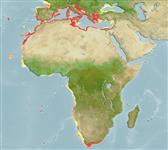>
Eupercaria/misc (Various families in series Eupercaria) >
Sparidae (Porgies)
Etymology: Diplodus: Greek, diploos = twice + Greek, odous = teeth (Ref. 45335).
Environment: milieu / climate zone / depth range / distribution range
Οικολογία
Θαλασσινό(ά) βενθοπελαγικό; ωκεανόδρομο(ς) (Ref. 51243); εύρος βάθους 0 - 160 m, usually 0 - 30 m (Ref. 13780). Subtropical; ? - 25°C (Ref. 130592); 50°N - 40°S, 26°W - 36°E
Eastern Atlantic: Bay of Biscay to Cape Verde and the Canary Islands including the Mediterranean and Black Sea (off Bulgaria); also from Angola to South Africa.
Length at first maturity / Μέγεθος / Βάρος / Age
Maturity: Lm 16.6 range ? - ? cm
Max length : 45.0 cm TL αρσενικό/απροσδιόριστο; (Ref. 3397); common length : 22.0 cm TL αρσενικό/απροσδιόριστο; (Ref. 3397); μεγ. δημοσιευμένο βάρος: 1.3 kg (Ref. 40637)
A euryhaline species inhabiting rocky and sometimes sandy bottoms to depths of 160 m, but more commonly in less than 50 m. The young are sometimes found in seagrass beds. Adults feed on crustaceans, worms and mollusks (Ref. 3688). Important food fish.
Potentially hermaphroditic (Ref. 4781).
Bauchot, M.-L. and J.-C. Hureau, 1990. Sparidae. p. 790-812. In J.C. Quero, J.C. Hureau, C. Karrer, A. Post and L. Saldanha (eds.) Check-list of the fishes of the eastern tropical Atlantic (CLOFETA). JNICT, Lisbon; SEI, Paris; and UNESCO, Paris. Vol. 2. (Ref. 3688)
IUCN Red List Status (Ref. 130435)
Threat to humans
Harmless
Human uses
αλιεία: Εμπορικό(ά); αλιεία αναψυχής: ναί; Ενυδρείο: Εμπορικό(ά)
Εργαλεία
Special reports
Download XML
Διαδικτυακές πηγές
Estimates based on models
Preferred temperature (Ref.
123201): 15.9 - 21.6, mean 18.8 °C (based on 248 cells).
Phylogenetic diversity index (Ref.
82804): PD
50 = 0.5000 [Uniqueness, from 0.5 = low to 2.0 = high].
Bayesian length-weight: a=0.01230 (0.01097 - 0.01380), b=3.05 (3.02 - 3.08), in cm total length, based on LWR estimates for this species (Ref.
93245).
Τροφικό Επίπεδο (Ref.
69278): 3.5 ±0.1 se; based on diet studies.
Generation time: 4.3 (2.8 - 5.5) years. Estimated as median ln(3)/K based on 16
growth studies.
Ελαστικότητα (Ref.
120179): Μεσαίο(α), ελάχιστος χρόνος για διπλασιασμό πληθυσμού 1,4 - 4,4 έτη (K=0.26-0.4; tmax=6; tm=2).
Fishing Vulnerability (Ref.
59153): Low to moderate vulnerability (33 of 100).
Climate Vulnerability (Ref.
125649): Low vulnerability (23 of 100).
Nutrients (Ref.
124155): Calcium = 49.2 [25.2, 92.2] mg/100g; Iron = 0.766 [0.416, 1.387] mg/100g; Protein = 18.8 [17.8, 19.7] %; Omega3 = 0.345 [0.189, 0.641] g/100g; Selenium = 29.6 [13.1, 62.5] μg/100g; VitaminA = 24.3 [6.3, 92.6] μg/100g; Zinc = 0.919 [0.627, 1.322] mg/100g (wet weight); based on
nutrient studies.
